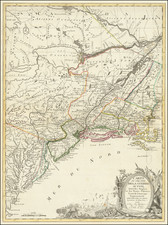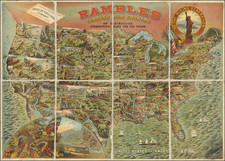Extremely rare, old color example of the proof state of De Fer's rare 1 sheet map of the inhabited parts of North America, based upon Nicholas De Fer's landmark 4 sheet map published in 1718.
At the top left of the map is large scale map of the Mississippi Delta and Mobile Bay, based upon the 1699 voyage of Pierre Le Moyne d'Iberville. The inset also appears on De L'Isle's 1718 carte de la Louisiane. D'Ibeville epxlored the mouth of the Mississippi and its many tributaries, including the Red River in Arkansas.
Heidenreich and Dahl surmised that that the map was issued to promoted the recently established Compagnie Francoise Occident and reinforce French opinion in the 1713 boundary settlement. The settlement was initially successful in promoting French emigration to America. However, the financing side of the company, conceived by John Law to help finance the debt left by by Louis XIV, led to a wild burst of speculation and ultimate collapse. This episode is often referred to as the Mississippi Bubble.
The map includes a a nice plan and view of Quebec, and fine detail in the Great Lakes and Mississippi. The proof state of the map predates the addition of the cartouche, vignettes, sailing ships, depictions of Indian Villages and other decorative features. Very Rare.
Nicholas de Fer (1646-1720) was the son of a map seller, Antoine de Fer, and grew to be one of the most well-known mapmakers in France in the seventeenth century. He was apprenticed at twelve years old to Louis Spirinx, an engraver. When his father died in 1673, Nicholas helped his mother run the business until 1687, when he became the sole proprietor.
His earliest known work is a map of the Canal of Languedoc in 1669, while some of his earliest engravings are in the revised edition of Methode pour Apprendre Facilement la Geographie (1685). In 1697, he published his first world atlas. Perhaps his most famous map is his wall map of America, published in 1698, with its celebrated beaver scene (engraved by Hendrick van Loon, designed by Nicolas Guerard). After his death in 1720, the business passed to his sons-in-law, Guillaume Danet and Jacques-Francois Benard.









![[Early Montana Territory Shown Above Idaho] Johnson's New Military Map of the United States Forts, Military Posts & all the Military Divisions with Enlarged Plans of the Southern Harbors . . . (Shows Military Departments)](https://storage.googleapis.com/raremaps/img/small/93868.jpg)
![L'Amerique Septentrionale Divisée en ses Principaux Etats [Sea of the West]](https://storage.googleapis.com/raremaps/img/small/99018.jpg)
![[ Exceptional original hand-color with highlights in gold ] Typus Aspectuum Oppositionum Et Coniunctionum Etz In Planetis](https://storage.googleapis.com/raremaps/img/small/81866.jpg)
![[ Atlantic Ocean / Triangular Trade / Negroland ]](https://storage.googleapis.com/raremaps/img/small/65187.jpg)

